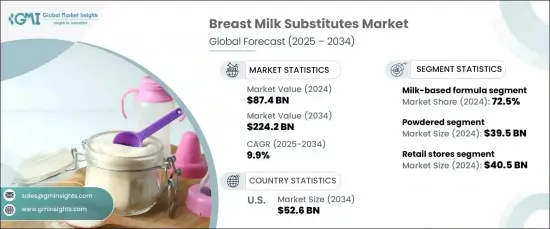
세계의 모유 대체품 시장은 2024년 약 874억 달러로 평가되었으며, 2025년부터 2034년까지 연평균 복합 성장률(CAGR) 9.9%로 성장할 것으로 예측됩니다.
모유 대체품은 모유 수유가 불가능하거나 불충분하거나 추가 영양이 필요한 경우 특히 유아용 준비 분유의 형태로 모유를 대체하도록 설계된 제품을 의미합니다. 이러한 대체품은 일반적으로 콩, 우유 또는 기타 식물성 단백질로 만들어지며, 모유의 영양 프로파일을 모방하기 위해 필수 영양소가 강화되는 경우가 많습니다.

모유 대체품에 대한 수요 증가에는 몇 가지 요인이 있습니다. 많은 어머니는 스트레스, 과거 수술, 모유 분비에 영향을 미치는 의학적 상태 등 다양한 문제로 모유 수유에 어려움을 겪고 있습니다. 또한 모유 대체품의 혁신은 시장 성장 추진에 중요한 역할을 합니다. 모유를 충실하게 재현하는 밀가루 우유의 새로운 발전은 동물성 미사용 옵션을 포함하여 더 건강한 대안을 찾는 부모로부터 주목을 받고 있습니다.
| 시장 범위 | |
|---|---|
| 시작 연도 | 2024 |
| 예측 연도 | 2025-2034년 |
| 시작 금액 | 874억 달러 |
| 예측 금액 | 2,242억 달러 |
| CAGR | 9.9% |
도시화에 의해 핵가족화가 진행되고 모유 육아를 지원하는 전통적인 지원 시스템이 감소하고 있습니다. 이러한 변화로 인해 모유 수유에 전념하는 시간, 자원 및 지원이 부족한 어머니에게 모유 대체품이 더욱 매력적이 되고 있습니다. 세계 통계에 따르면 유아의 상당한 비율이 처음 6개월 동안 모유만으로 키워지지 않고 모유 육아를 계속하는 데 많은 어머니가 직면하고 있는 과제가 부각되고 있습니다.
시장은 콩 기반 분말 우유, 우유 기반 분말 우유, 낮은 알레르기성 분말 우유 및 기타를 포함한 대체 제품 유형별로 구분됩니다. 우유 기반 분말 우유는 시장을 독점하고 가장 큰 점유율을 차지합니다. 모유 부족, 모체 건강 문제, 질병 변속 우려 등 건강 관련 이유로 어머니는 우유 기반 분말 우유를 선택하는 경우가 많습니다. 이 우유는 DHA, ARA, 프로바이오틱스, 프리바이오틱스와 같은 영양소로 더욱 강화되어 뇌 발달, 면역 기능, 소화기계의 건강을 지원하며 모유에 가깝습니다.
분말 우유 유형별로 볼 때 시장은 분말 유형, 농축 액체 유형, 즉시 사용할 수있는 유형으로 나뉩니다. 밀크 우유는 편의성, 비용 효과 및 보존의 용이성에서 시장을 선도합니다. 특히 바쁜 부모와 신선한 우유를 얻기 어려운 지역에 사는 부모는 분말 우유를 선호하는 경우가 많습니다. 유기농 및 특수 우유와 같은 프리미엄 유형에 대한 수요는 아기의 건강 요구를 충족시키는 선택을 부모가 요구함에 따라 증가하고 있습니다.
모유 대체품의 유통 채널에는 약국, 소매점 및 기타 상점이 포함됩니다. 소매점은 지배적인 유통 채널이며 도시와 농촌 지역에서 모유 대체품을 널리 사용할 수 있습니다. 약국과 아기 용품 전문 소매점은 소비자가 이러한 제품을 얻을 수 있도록하는 데 중요한 역할을하며 시장 성장에 기여합니다.
미국의 모유 대체품 시장은 2034년까지 526억 달러에 이를 것으로 예상됩니다. 일하는 어머니는 아기와 떨어져 있어도 편리한 모유 수유 방법을 요구하기 때문에 어머니의 취업률의 높이가 모유 대체품 수요를 촉진하는 주요 요인이 되고 있습니다. 이 동향은 현대의 육아에서 모유 대체품이 하는 역할이 커지고 있음을 뒷받침하고 있습니다.
The Global Breast Milk Substitutes Market was valued at approximately USD 87.4 billion in 2024 and is projected to grow at a CAGR of 9.9% from 2025 to 2034. BMS refers to products designed to replace breast milk, particularly in the form of infant formula, when breastfeeding is not possible, insufficient, or when additional nutrition is required. These substitutes are commonly made from soy, cow's milk, or other plant-based proteins and are often enriched with essential nutrients to mimic the nutritional profile of breast milk.

Several factors are contributing to the increasing demand for BMS products. Many mothers face challenges with breastfeeding due to various issues such as stress, previous surgeries, or medical conditions affecting milk production. Additionally, innovations in BMS products are playing a significant role in driving market growth. New advancements in formulas that closely replicate breast milk, including animal-free options, are attracting attention from parents seeking healthier alternatives.
| Market Scope | |
|---|---|
| Start Year | 2024 |
| Forecast Year | 2025-2034 |
| Start Value | $87.4 Billion |
| Forecast Value | $224.2 Billion |
| CAGR | 9.9% |
Urbanization has led to a rise in nuclear families, reducing the traditional support systems that would assist in breastfeeding. This shift makes BMS products more appealing to mothers who may lack the time, resources, or support for exclusive breastfeeding. According to global statistics, a significant percentage of infants are not exclusively breastfed for the first six months, highlighting the challenges many mothers face in sustaining breastfeeding.
The market is segmented by substitute type, including soy-based formula, milk-based formula, hypoallergenic formula, and others. Milk-based formulas dominate the market, accounting for the largest share. Health-related reasons, such as insufficient milk supply, maternal health issues, and concerns about disease transmission, often lead mothers to opt for milk-based formulas. These formulas are further enhanced with nutrients like DHA, ARA, probiotics, and prebiotics, which support brain development, immune function, and digestive health, making them a closer match to breast milk.
In terms of formula type, the market is divided into powdered, concentrated liquid, and ready-to-use formulas. Powdered formulas lead the market due to their convenience, cost-effectiveness, and ease of storage. Parents, especially those with busy schedules or living in areas with limited access to fresh milk, often prefer powdered formulas. The demand for premium variants, such as organic and specialty formulas, is growing as parents seek options that meet their babies' specific health needs.
Distribution channels for BMS products include pharmacies, retail stores, and other outlets. Retail stores are the dominant distribution channel, offering widespread access to BMS products in both urban and rural areas. Pharmacies and specialized baby product retailers play an important role in making these products available to consumers, contributing to the market's growth.
In the U.S., the BMS market is expected to reach USD 52.6 billion by 2034. High maternal employment rates are a major factor driving the demand for BMS products, as working mothers seek convenient feeding options when away from their babies. This trend underscores the growing role of breast milk substitutes in modern parenting.